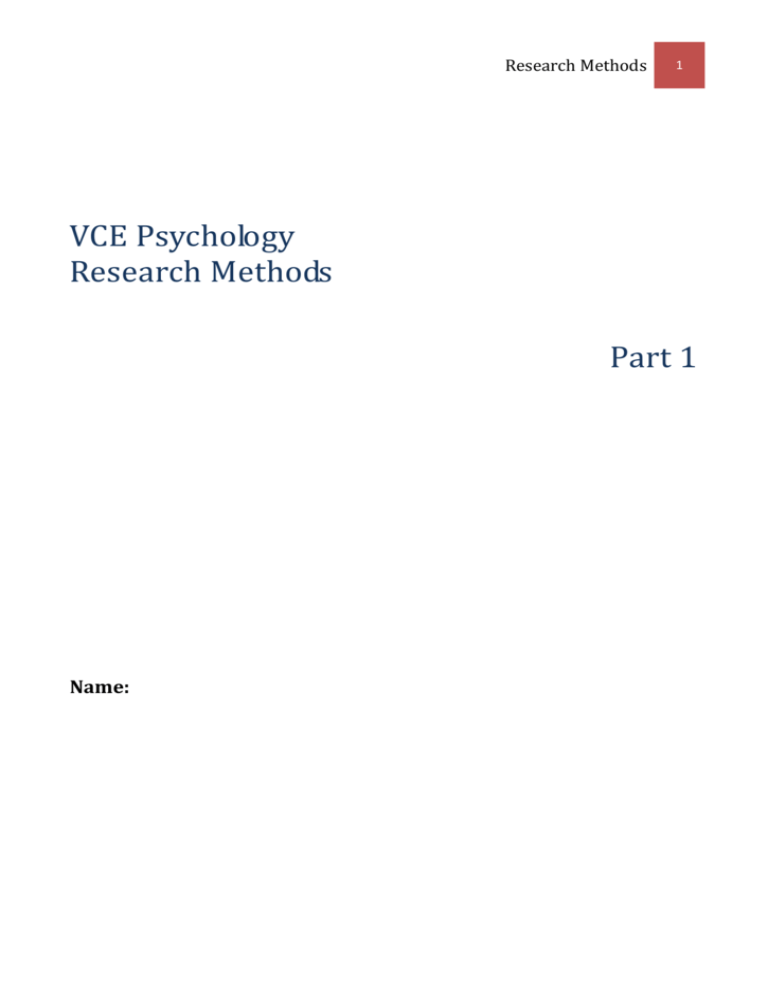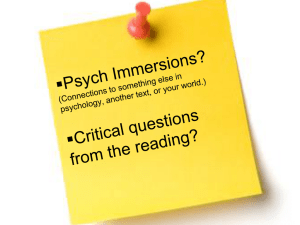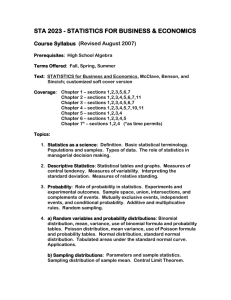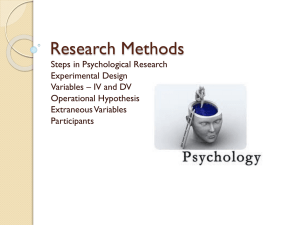Research Methods Unit 3
advertisement

Research Methods 1 VCE Psychology Research Methods Part 1 Name: Research Methods 2 What is a hypothesis? A hypothesis is a statement that predicts or makes an educated guess about the relationship between variables which can be tested empirically. When stated correctly, a hypothesis should incorporate the key variables in the prediction – that is, the independent and dependent variables. It should clearly identify the variable that will be manipulated (independent variable) to produce the change in the behaviour (dependent variable). What is an operational hypothesis? An operational hypothesis outlines the direction of the proposed research. It is a precise statement that describes clearly defined and measurable variables to show how they operate on behaviour and to what extent, so that the information (data) collected can be statistically analysed. Operationalisation is the process by which a hypothesis is changed from a broad, general statement about the relationship between variables, to an experimental or operational (working) hypothesis. By operationalising the hypothesis, it becomes workable, testable and repeatable, and the validity of such investigations can therefore be assessed. In the research hypothesis ‘Athletes perform better under stress’, the variables have yet to be defined or operationalised. If a researcher wanted to investigate the prediction about athletes, she would need to operationalise the hypothesis and define what sort of athletes (sprinters, canoeists, high jumpers, and so on), the type of stress (physical, mental, emotional, and so on), how this stress was to be measured (heart rate, skin conductivity, and so on) and performance (times, height, distance, and so on). The operationalised hypothesis might then be: ‘Women sprinters aged 20-25 years will improve their performance times by ten seconds in 100-metre track races, when subjected to a coach’s bullying (emotional stress).’ Other examples: 1. Hypothesis: Children can understand that the amount of liquid remains the same even if the shape of the container changes. Operational hypothesis: Twelve-year-old children will understand that one litre of water in a 3cm flat pan is still one litre when poured into a narrow cylindrical jar 10cm tall. 2. Hypothesis: The time taken for a pigeon to learn a dance routine decreases as rewards increase. Operational hypothesis: If a pigeon is rewarded with three food pellets for each step learned in a 35step dance routine, then it will take the pigeon three days to learn the routine, compared with five days if it receives only one food pellet per step. There may be occasions when the researcher is uncertain whether the independent variable actually causes changes in the dependent variable. A null hypothesis states that there is no significant relationship between the variables. In the case of the athletes, it would state that a group of athletes exposed to stress and a group of athletes not exposed to stress will perform the same. A hypothesis can also be ‘directional’ or ‘non-directional’. A directional hypothesis (‘one tailed’) is one predicting that the dependent variable will change and the particular direction of that change, for example: ‘Doubling training time of sprinters will halve performance times.’ A non-directional (‘two-tailed’) is one predicting that the dependent variable will change, but not indicating the direction of that change, for example: ‘Drinking caffeinated coffee while studying will affect memory.’ Research Methods 3 Activity 1 – Identifying hypotheses Study the following list of hypotheses and identify which are general, null or operational hypotheses. 1. Development varies between individuals. _________________________________________________________________________ 2. There is no difference between Type A and Type B personalities. _________________________________________________________________________ 3. More intense physiological changes, as measured by increased heart rate, will occur when a fake spider is presented to a group of ten-year-old girls, compared with a group of ten-year-old boys. _________________________________________________________________________ 4. Attention does not affect an individual’s perception. _________________________________________________________________________ 5. People dream in Stage 4 sleep. _________________________________________________________________________ 6. An individual is more likely to remember words that are meaningful than to remember nonsense syllables, when presented with a list of 20 items to memorise. _________________________________________________________________________ Activity 2 – Formulating hypotheses For each scenario: i) Identify the independent variable (IV) ii) Identify the dependent variable (DV) iii) Formulate your own operational hypothesis Scenario 1 Dr Hunter wants to research the influence of caffeine on memory ability in middle-aged men. He gives his experimental group four cups of coffee a day and then measures the number of words they recall on a series of short-word recollection tests. The control group completes the same test but does not consume any caffeine. IV: ______________________________________________________________________________________ DV: _____________________________________________________________________________________ Hypothesis: ________________________________________________________________________________________ ________________________________________________________________________________________ ________________________________________________________________________________________ Research Methods 4 Scenario 2 A teacher was disappointed with the mid-year exam result achieved by her class, and wanted to improve her students’ learning for the end-of-year exam. She purchased many different-coloured whiteboard markers and during second semester she used a variety of colours on her board instead of just black, which she had used in the first semester. IV: ______________________________________________________________________________________ DV: _____________________________________________________________________________________ Hypothesis: ________________________________________________________________________________________ ________________________________________________________________________________________ ________________________________________________________________________________________ Scenario 3 The Ferrari team wanted to see if their drivers’ reaction times would improve if they fitted the cars with gauges that gave digital readouts rather than the conventional dial and needle configuration. IV: ______________________________________________________________________________________ DV: _____________________________________________________________________________________ Hypothesis: ________________________________________________________________________________________ ________________________________________________________________________________________ ________________________________________________________________________________________ Scenario 4 Dr Woodford, a psychologist, was concerned about the levels of stress in local council employees. He wanted to investigate whether he could lower their stress levels, as measured by a self-report inventory by medicating them daily with Clarinodroxyl. A control group completed the same inventory but did not take any of the medication. IV: ______________________________________________________________________________________ DV: _____________________________________________________________________________________ Hypothesis: ________________________________________________________________________________________ ________________________________________________________________________________________ ________________________________________________________________________________________ Research Methods 5 What are the different types of variables? There are four types of variables that can be identified in experimental research. They are independent variables, dependent variables, extraneous variables and confounding variables. The independent variable is the variable in an experiment that is systematically changed or varied by the experimenter in order to measure its effect on the dependent variable. The dependent variable is the variable in an experiment that is observed or measured and is expected to change as a result of the manipulation of the independent variable (essentially, the participant’s response). An extraneous variable is any variable other than the independent variable that can cause a change in the dependent variable and therefore affect the results of the experiment in an unwanted way. A confounding variable is a variable other than the independent variable that has an unwanted effect on the dependent variable, making it impossible to determine which of the variables produces the change in the dependent variable. An example of a confounding variable: In a study that aimed to find out if listening to music (IV) would improve the recall of a poem (DV), the researcher would obviously like to conclude that if the scores of the experimental group were significantly higher than those of the control group, then this was due to the presence of the music. However, if the participants in the experimental group had a better memory than those in the control group, the difference in the results might not be attributable to the music at all, but to the participants’ memory ability. The simplest experiments use on independent variable with two values or levels (an experimental condition and a control condition) and one dependent variable. In the experimental condition (experimental group), the independent variable is present. In the control condition (control group), the independent variable is absent. Activity 3 – Identifying variables and groups Identify the independent variable, the dependent variable and the experimental and control groups in the following experiments: 1. Educational researchers were interested in seeing if wearing a uniform to school created a greater feeling of belonging, and enhanced school spirit. After receiving permission from the schools involved, researchers administered a questionnaire on group belonging and school spirit to 200 students. Of these, 100 students were required to wear a school uniform, and the other 100 students attended school in casual clothing. The information collected was converted to quantitative data, and a score of school belonging was calculated for each group. IV: _______________________________________________________________________________ DV: _______________________________________________________________________________ Experimental group: _________________________________________________________________ Control group: ______________________________________________________________________ Research Methods 6 2. Various groups in society were concerned about the gradual increase in the number of drink-driving offences on the road. After a public forum and several meetings to discuss the issue, the collective group decided to see if shock advertising in the media would change people’s behaviour. For the next three months, shocking advertisements about the implications of drink driving were aired on television and put in newspapers. After the advertising campaign, the number of drink-driving offences before and after the three-month period was compared. No change was found. IV: _______________________________________________________________________________ DV: _______________________________________________________________________________ Experimental group: _________________________________________________________________ Control group: ______________________________________________________________________ 3. The owner of a company wanted to see if employees with a divergent thinking style were more able to solve problems than those with a convergent thinking style. She called in a psychologist to test her employees for thinking style and to select 50 divergent thinkers and 50 convergent thinkers. The employees were asked to complete, in two hours, a set of problems related to their daily occupations. The mean number of problems correctly solved was then calculated for each group. IV: _______________________________________________________________________________ DV: _______________________________________________________________________________ Experimental group: _________________________________________________________________ Control group: ______________________________________________________________________ 4. A psychologist wanted to investigate if remembering a set of 20 nonsense syllables is affected by the amount of sleep a person has had. She instructed 30 volunteer participants to sleep at the laboratory for one night. The participants were divided into two groups: one group was allowed to go to sleep at 10pm, while the other group had to stay awake until 4am. Both groups were woken at 8am and were given half an hour to learn and remember a list of 20 nonsense syllables. After the half hour, the participants were tested on how many syllables they remembered, in any order. IV: _______________________________________________________________________________ DV: _______________________________________________________________________________ Experimental group: _________________________________________________________________ Control group: ______________________________________________________________________ Research Methods 7 Activity 4 – Identifying confounding variables Identify the confounding variables in the following experiments and explain why they create a problem in the experiment. 1. A developmental psychologist conducted a study to see if three-week old infants look at colour images for a longer period of time than they look at black and white images. He tested ten threeweek-old infants separately. Each infant was placed in a cot, looking up at a mobile. The mobile had a series of colour images of animals on the left-hand side, and a series of black and white images of food on the right-hand side. The psychologist observed the infant and timed how long he/she focused on the left or right side of the mobile. He repeated this for the other nine infants. After he collated and analysed the data, he concluded that three-week-old infants focus longer on colour images. The confounding variable is: __________________________________________________________________________________ __________________________________________________________________________________ __________________________________________________________________________________ __________________________________________________________________________________ __________________________________________________________________________________ __________________________________________________________________________________ 2. A researcher wanted to find out if studying in natural light was more effective than studying in artificial light. Two groups of volunteers were given the same history topic to learn in three hours, from 1pm until 4pm. One group studied the topic outside in natural light, and the other in a room with no windows and only fluorescent light. After three hours of studying, both groups were tested on how much they remembered of the history topic. The confounding variable is: __________________________________________________________________________________ __________________________________________________________________________________ __________________________________________________________________________________ __________________________________________________________________________________ __________________________________________________________________________________ __________________________________________________________________________________ Research Methods 8 Identifying extraneous variables There are a number of different types of extraneous variables. These include: individual participant differences, demand characteristics, placebo effects, experimenter effects, order effects, artificiality and the use of non-standardised instructions and procedures. Activity 5 – types of extraneous variables Write a brief description of each type of extraneous variable in the table below. Extraneous Variable Individual participant variables Demand characteristics Placebo effects Experimenter effects Order effects Artificiality Non-standardised instructions and procedures Description Research Methods 9 Controlling and minimising extraneous variables Ways to control and minimise the effects of extraneous include: participant selection and allocation, counterbalancing, single-blind procedures, double-blind procedures, placebos, standardised instructions and procedures and experimental research designs (repeated-measures, matched-participants and independentgroups). Activity 6 – methods to minimise extraneous variables Write a brief description of each method of minimising extraneous variables in the table below. Method Participant selection and allocation Counterbalancing Single-blind procedure Double-blind procedure Placebo Standardised instructions and procedures Experimental research design Description Research Methods 10 Activity 7 – extraneous variables Read the following scenarios and identify the extraneous variable in each. Then use Table 1 to identify the type of extraneous variable and Table 2 to identify the method that could be used to minimise the extraneous variable. Table 1: types of extraneous variables Table 2: methods to minimise extraneous variables Order effect Experimenter effect Single-blind procedure Matched-participants design Placebo effect Participant variables Double-blind procedure Counterbalancing Scenario 1 Maddi was conducting research investigating the effect of music on study. She gave her participants a list of names starting with ‘A’ and asked them to learn it in silence. After one minute they wrote down all the names they could recall. She then handed the same group of participants another list of names starting with ‘A’ and she played music as they were learning the names. After one minute they wrote down all the names they could recall. Extraneous variable: _______________________________________________________________________ Type of extraneous variable: _________________________________________________________________ Method to minimise extraneous variable: ______________________________________________________ Scenario 2 A teacher decides to give students in half of his class a new ‘super-drug’ he has discovered, which is intended to improve their intelligence. The students in the other half of the class are told they will receive no drug and will have to compete academically with the rest of the class as best they can. Extraneous variable: _______________________________________________________________________ Type of extraneous variable: _________________________________________________________________ Method to minimise extraneous variable: ______________________________________________________ Scenario 3 Psychville Basketball Club is trying to test the effectiveness of a new training program on shooting accuracy. The put their 10 tallest players through the training program and then asked them to shoot 100 balls from the three-point line. Their 10 shortest players did not complete the training program, but also shot 100 balls from the three-point line. The shooting accuracy of both groups was then compared. Extraneous variable: _______________________________________________________________________ Type of extraneous variable: _________________________________________________________________ Method to minimise extraneous variable: ______________________________________________________ Scenario 4 Minh is a university graduate researching whether caffeine can improve driving ability. She is hoping that this is the case so that she can write a thesis on it. Group A ingests caffeine before taking a simulated driving test, and Group B does not ingest any caffeine before taking a simulated driving test. As members of Group A are taking their driving test, Minh actively encourages them. When members of Group B taking their driving test, Minh stands over them and points out their errors. Extraneous variable: _______________________________________________________________________ Type of extraneous variable: _________________________________________________________________ Method to minimise extraneous variable: ______________________________________________________ Research Methods 11 Activity 8 – Which experimental research design is which? Complete the table by filling in the definitions, advantages and disadvantages of each experimental design. Experimental design Repeated measures Matched participants Independent groups Definition Advantages Disadvantages Research Methods 12 Activity 9 – identifying experimental designs Choose the appropriate experimental design (repeated measures, matched participants, independent groups) to the scenario. 1. A study with a small number of participants. __________________________________________________________________________________ 2. A study that compares before and after scores. __________________________________________________________________________________ 3. A study where experimenters have little money. __________________________________________________________________________________ 4. A study using identical twins. __________________________________________________________________________________ 5. A study that seeks to compare two unrelated groups. __________________________________________________________________________________ 6. An important study into cancer research. __________________________________________________________________________________ 7. A study requiring 2000 people. __________________________________________________________________________________ Sampling procedures The process of selecting participants for a research study is called sampling. A sample is a group that is a subset or portion of a larger group (population) chosen to be studied for research purposes. A population is the larger group from which a sample is drawn. There are four main types of sampling; convenience, random, stratified and stratified-random. Convenience sampling or ‘opportunity sampling’ is the method of selecting participants who are readily available without any attempt to make the sample representative of a population. Random sampling is a method of sampling that ensures that each member of the target population has an equal chance of being chosen to be part of the sample. Stratified sampling is a method of sampling that involves dividing the population to be sampled into distinct subgroups (strata), then selecting a separate sample from each stratum in the same proportions as they occur in the population of research interest. Stratified-random sampling is a method of sampling that involves identifying all of the people within each subgroup (stratum) of research interest, then randomly selecting samples of proportionate size from within each subgroup. Research Methods 13 How do participants take part in an experiment? Participants can be assigned to one of two groups – the experimental group or the control group. Usually participants are randomly allocated, meaning that a participant has an equal chance of being a member of either the experimental group or the control group. Activity 10 – Identification of participants Identify the participants, the sampling method (random or stratified) and the type of group (experimental or control) in the following. 1. A researcher wanted to investigate the extent to which teachers are able to correctly assess the intelligence of their students. She hypothesised that there would be a relationship between teachers’ appraisals of students’ intellectual ability, and students’ scores on the WISC-III test. She selected 50 twelve-year-old girls from a Catholic girls’ college. She gave the students a WISC-III test to evaluate their IQ and also collected a teacher’s report on each student’s academic performance. The researcher ranked the students according to their indicated IQ. She then ranked the students according to the teacher observations. From the results, the researcher concluded that there was a correlation between test scores and teacher predictions regarding a student’s academic potential. The participants are: _________________________________________________________________ The sample is: ______________________________________________________________________ The control group is: _________________________________________________________________ The experimental group is: ____________________________________________________________ 2. A researcher wanted to investigate stress among teenagers. He hypothesised that students could easily identify their stressors. The researcher attended a VCE Summer School comprising 120 Year 12 students – 60 male and 60 female. Of these students 50% came from private schools, and 50% came from government schools. The researcher selected 60 students attending the seminar, and asked each to comment on his/her view of life. The other group of 60 students were given a brief lecture on the importance of succeeding despite life’s setbacks, and were shown a video depicting poverty in Australia. Both groups were then surveyed to indicate reactions to school and exam pressures, relationships and world crises. The researcher evaluated all responses and concluded that being in touch with life’s realities generally increased stress levels among teenagers. The participants are: _________________________________________________________________ The sample is: ______________________________________________________________________ The control group is: _________________________________________________________________ The experimental group is: ____________________________________________________________ Research Methods 14 Activity 11 – Sampling summary table Fill in the table on sampling using the appropriate information below. Members of the population are broken into groups, or strata, based on particular characteristics; a proportionate number of members in each group is then selected for the sample. The sample may not be representative of the population. It is time-and cost-effective to select a large sample. The sample is likely to be biased. Sampling the first 20 people who enter the library. Participants are selected for the sample based on the ease of access and selection. The sample has a proportionate number of participants representing each characteristic in the population. Although the sample is a representative sample, the participants are selected from each characteristic may be biased. Sampling students by writing down all of their names and then drawing five names from a hat. The sample is representative of the population. It takes a lot of resources (time and money) to select a sample. Type of sampling Convenience Random Stratified Stratifiedrandom Definition The sample is very easy to obtain. Advantage Disadvantage Members of the population are broken into groups, or strata, based on particular characteristics; a proportionate number of members in each group is then randomly selected for the sample. Every member of the population has an equal chance of being selected for the sample. Separating a year level into male and female students and then pulling out 10 boys’ names and 10 girls’ names from two separate hats. Separating a year level into male and female students and then selecting the first females and males that you see. Example of use








